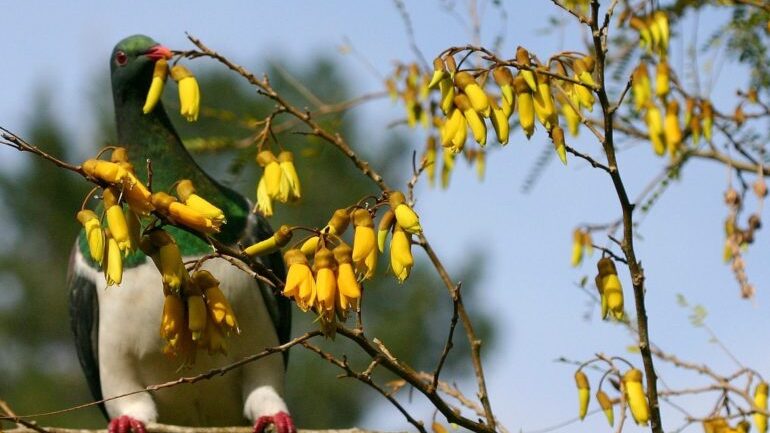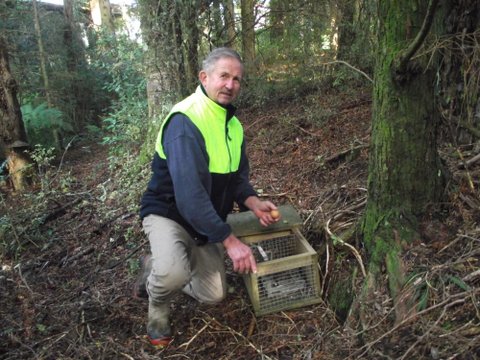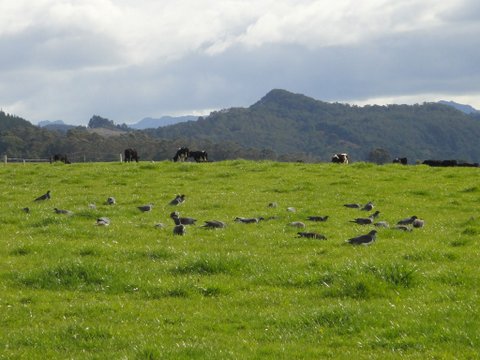The magnolias aren’t looking too good at Arthur Hinds’ place. His wife Diane used to complain about the damage possums were doing. But that’s not the problem nowadays.

The Department of Conservation dealt to the possums in 2000, just before the Whenuakite Kiwi Care Group started their predator control programme. Arthur joined the Kiwi Care Group early on and today Diane’s magnolias are the victims of the group’s success. Their buds are devastated by an exploding population of kereru.
“The damage from the kereru is much worse,” says Arthur. “The possums ate the buds, but the kereru are killing the trees.”
It’s a good problem to have, however and it’s not just kereru that are flourishing. Kaka are kicking up a racket everywhere on Arthur’s block and the Coromandel brown kiwi at Whenuakite – the birds that Arthur and his colleagues first set out to help – have had the fastest increase in population recorded anywhere in New Zealand. It’s quite an achievement!
So how did it all come about?

Sixteen years ago things weren’t looking so good for kiwi on the Coromandel. Whenuakite had previously been identified as a kiwi ‘hot spot’ when Sid Marsh, under contract to the Department of Conservation (DOC), went through the peninsula in 1993-1994, surveying kiwi from Moehau to Whangamata. But by 2000, numbers were declining to such an extent that DOC called a public meeting to rally support for the birds. Following on from that public meeting, the first meeting of the Whenuakite Kiwi Care Group was held on 5 September 2000 and the group began trapping in 2001.
Patrick Stewart, an independent contractor from Red Admiral Ecology was hired to do the first kiwi call survey in 2001 and has continued to survey kiwi numbers for the group at regular intervals since. In that first survey, Patrick and his team assessed kiwi numbers over 2700 ha, with 24 listening posts at high points. They listened for 3 non-consecutive, fine-weather nights (the nearby sea gets too noisy during rough weather), for a total of 2 hours per night. For the first hour the researcher would listen, then for the second hour they would play a tape soliciting kiwi calls.
After analysing the results, building in factors such as male/female ratios, Patrick Stewart’s team determined that there were 29 kiwi present in that first survey. The same team returned in 2005 to repeat the process, using 23 listening points instead of 24. This time they detected 68 birds.
“The experts were blown away,” says Arthur.
And the numbers have kept steadily increasing ever since.
“In 2010 they detected 98 kiwi,” Arthur says, “and in 2015 there were 150 kiwi – 93 males and 57 females. Based on the number counted in the survey, they estimated there were 112 breeding pairs in the area. Patrick Stewart has calculated there is a 13% annualised increase.”
The Whenuakite Kiwi Care Group have a predator control regime that is clearly working, so what has it involved? In 1999/2000 ground control was carried out using brodifacoum on the outer portion of the land and 1080 internally. A total of 104 goats were also removed from the area.
“It decimated possums and may have taken out stoats as well,” says Arthur. “Kereru numbers exploded and the bush flourished. We kept putting in more and more traps.”
But in 2006 when another ground control bait poisoning operation was proposed, the track cutting cost came in at $80,000-$120,000. In spite of his own reservations at the time, Arthur suggested that they use aerial 1080.
“It nearly pulled the group apart,” says Arthur. “Some were totally opposed. Others had reservations. I was very concerned, even though I suggested it and on my own place I monitored it very keenly. I look for dead birds every drop and I’ve never seen them. I’ve found dead rats and dead (feral) cats.”

There have now been four aerial 1080 drops to boost the group’s predator control efforts on the ground – in 2006, 2009, 2011 and 2015.
“There’s been a massive improvement in forest health,” Arthur says. “All the native birds have increased dramatically.”
Currently there are 540 traps in place, mainly DOC 200s, with about 110km of traplines. They are checked once a month by a small group of volunteers who put in 2500 hours of volunteer time per year. To date, 1498 stoats have been trapped.
Zealgold Foods, a national egg distributer donates around 600 eggs per month for trap lures and has done right from the day the group started. BNZ Waikato staff help out too. They look after two traplines once a month and also hold ‘Closed for Good’ days where they volunteer as a group.
“One ‘Closed for Good’ day we had 20 over,” says Arthur. “They sometimes bring their kids which is great for the next generation.”
Arthur’s biggest concern these days is wandering dogs. The group has lost 6 kiwi to dogs on their conservation area. Three quarters of that land is in private ownership and three of the four major landowners are trustees of the Whenuakite Kiwi Care Group. The other 25% of the land belongs to DOC.
With dogs highlighted as a major issue for kiwi in the area, the three major landowners have instigated a tough dog control policy on their land. If a dog is found, it will be destroyed.
“It’s uncompromisingly hard, but successful,” says Arthur. “We’ve lost 8 kiwis that I’m aware of. Six of those were killed by dogs, one was run over and one we believe died of old age.”
Arthur’s group made a decision, right at the beginning, that they wouldn’t attach transmitters to their kiwi, so it is likely there have been other, unrecorded accidental kiwi deaths from dog attacks. The group won’t be changing their dog policy any time soon.
As kiwi numbers have increased, other birdlife has also benefitted for the predator control. Nowadays there are so many kereru around, that not only are they killing Arthur and Diane’s magnolias, but every spring and autumn they graze on pasture, seeking a bit of extra nitrogen in their diet. Arthur has been counting them every August since he first observed the phenomenon.
“There were about 20 or so kereru in 2008, after first 2006 drop of 1080. In 2010 there were 96 grazing on the pasture. In August 2011 the number was up to 121, then 146 (2012), 140-160 in one mob in 2013 (they got disturbed partway through counting) and 210 in 2014.”
The last count was in 2014. Since then, the kereru have stopped grazing in a single large mob and have dispersed over the property – still grazing on pasture in August, but no longer countable.
There have been changes in kaka numbers and behaviour too. The population used to be very male dominated. Females were vulnerable to stoats as they nested in tree-holes.
“In 2007/2008 we started to see family groups,” says Arthur. “The young ones would be clowning around and very vocal in the early morning. In 2010/2011 you would see 15-20 in a group, very vocal. Now they’re around all the time, but scattered in ones and twos and not as vocal.”
Arthur thinks the fact that kereru and kaka are no longer seen in big groups, even though their numbers continue to increase, is a reflection that they’re feeling more secure. They no-longer need the protection and security of numbers.
Other changes include morepork, seen out in the day getting greenfinches. They’re opportunist feeders and, as numbers have increased dramatically, morepork have moved out beyond the bush and expanded their hunting repertoire.
Kiwi feeding patterns have changed too.
“I used to notice probe marks of kiwi,” says Arthur, “but even though there are more kiwi, I don’t see the probe marks any more. The invertebrates have increased too, so the kiwi don’t have to probe to find food.”
Things are going well – but the story is far from over.
“It’s a forever project,” says Arthur, whose children and grandchildren will carry on the work one day. And, while the neverending story may not have a happy ending as such, it is a story of ongoing success (apart from those long-suffering magnolias of course).

